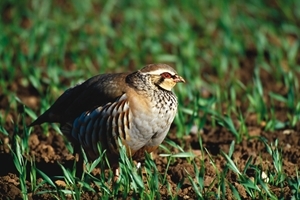Alectoris rufa
 The red-legged partridge (redleg) is not native to Britain, but was successfully introduced to East Anglia in about 1770, using stock from France. Although becoming well established by the end of the century, its spread across Britain was slow and its current distribution was not reached until the 1930s.
The red-legged partridge (redleg) is not native to Britain, but was successfully introduced to East Anglia in about 1770, using stock from France. Although becoming well established by the end of the century, its spread across Britain was slow and its current distribution was not reached until the 1930s.
Despite its introduced status, the conservation of the red-legged partridge in Britain is important because the natural range of the species is restricted almost entirely to three European countries (Spain, Portugal and France), where numbers are declining.
As one would expect from its Mediterranean origin, the red-legged partridge thrives on dry, sandy soils and breeds best in areas of high summer temperatures. It has been less susceptible than the grey partridge to the reduction in cereal insects since the 1950s because its chicks consume considerably more seeds and vegetable matter, even shortly after hatching. In the wild, the hen bird commonly lays two clutches, incubating one herself and leaving the other for the cock. Thus each pair has the potential to produce two broods more or less simultaneously.
This ability to lay two clutches has meant that the redleg also lays more in captivity, making it attractive to rear and release for sporting purposes. Starting in 1963, this practice increased rapidly as it was seen as a means of maintaining a partridge shoot despite the decline of the grey. In the late 1960s, game-farmers discovered that the closely related chukar partridge (Alectoris chukar) and chukar/redleg hybrids were nearly twice as prolific in captivity. The first ones were released in 1970 and they quickly became popular throughout lowland Britain. The disadvantage for the conservation of the wild red-legged partridge stock was three-fold:
- Chukars and hybrids bred much less well than pure redlegs in the wild
- Hybridisation threatened the genetic purity of the wild stock
- High levels of releasing induced an unsustainable shooting rate of wild redlegs
Out of concern for the wild red-legged partridge, the releasing of chukars and chukar/red-leg hybrids was prohibited in 1992. Since then, the breeding success of wild red-legged partridges has improved. Releases of pure red-legged partridges are estimated at about six million birds a year.
The current status of the wild red-legged partridge in Britain is difficult to assess because of the scale of releasing. Nevertheless, it seems that there has been a marked decline, at least since 1985. The British population size is estimated to lie between 90,000 and 250,000 pairs.
Get the Latest News & Advice
Join over 100,000 subscribers and stay updated on our latest advice, research, news and offers.
*You may change your mind any time. For more information, see our Privacy Policy.